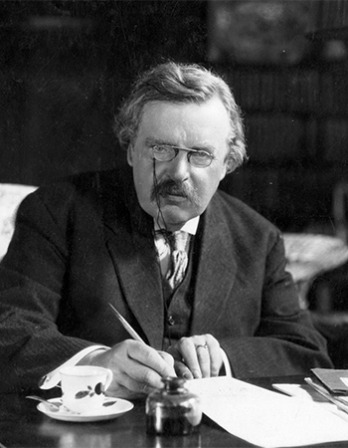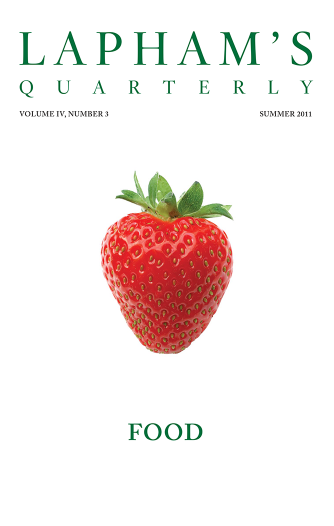Those who make the worst use of their time are the first to complain of its brevity.
—Jean de La Bruyère, 1688Time After Time
It’s possible to live in more than one time, more than one history of the world, without feeling a pressing need to reconcile them.
By John Crowley
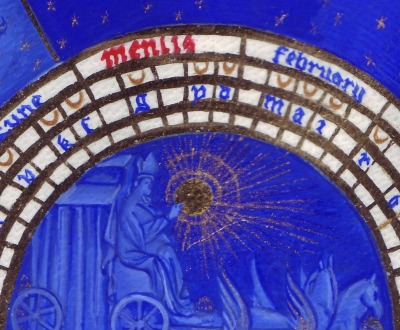
February (detail) from Les Très Riches Heures du Duc de Berry, c. 1412.
Then what is time?” St. Augustine asked himself in his Confessions. “I know what it is if no one asks; but if anyone does, then I cannot explain it.”
Augustine saw the present as a vanishing knife edge between the past, which exists no longer, and the future, which doesn’t yet. All that exists is the present; but if the present is always present and never becomes the past, it’s not time, but eternity. Augustine’s view is what the metaphysicians call “presentism,” which holds that a comprehensive description of what exists (an ontology) can and should include only what exists right now. But among the things that do exist now are surely such things as the memory of former present moments and what existed in them, and the archives and old calendars that denote or describe them. Like the dropped mitten in the Ukrainian tale that is able to accommodate animals of all sizes seeking refuge in it from the cold, the ever-vanishing present is weirdly capacious—“There’s always room for one more!”
Time is continuous, but calendars are repetitive. They end by beginning again, adding units to ongoing time just by turning in place, like a stationary bicycle. Most calendars these days are largely empty, a frame for our personal events and commitments to be entered in; but historically calendars have existed in order to control time’s passage with recurring feasts, memorials, sacred duties, public duties, and sacred duties done publicly—what the church I grew up in calls holy days of obligation. Such a calendar can model in miniature the whole of time, its first day commemorating the first day of Creation, its red-letter days the great moments of world time coming up in the same order they occurred in history, the last date the last day, when all of time begins again. The recent fascination with the Mayan “long count” calendar reflects this: the world cycle was to end when the calendar did.
It’s possible to live in more than one time, more than one history of the world, without feeling a pressing need to reconcile them. Many people live in a sacred time—what the religious historian Mircea Eliade called “a primordial mythical time made present”—and a secular time, “secular” from the Latin saeculum, an age or a generation. Sacred time, “indefinitely recoverable, indefinitely repeatable,” according to Eliade, “neither changes nor is exhausted.” In secular time, on the other hand, each year, month, second, is a unique and unrepeatable unit that disappears even as it appears in the infinitesimal present.
To live at once in a time recoverable by a particular sacred calendar and also by a time without qualities, counted as it passes, involves a sort of mental doubling that is perhaps comparable, in the richness it grants to thought and feeling, to growing up bilingual: two systems, each complete, funny when they collide, each supplying something the other lacks, bearing no command to choose between them. Like a hamster in a Run-About Ball, we can explore an endlessly generated world freely by turning inside the vehicle of our closed and demarcated calendars.
Toward the middle of the thirteenth century, a Dominican friar in Genoa, Jacobus de Voragine, set out to chronicle all that he knew about the history of the world, and to express that knowledge through the sacred events of the Christian year and the exemplary stories of the saints whose feast days filled it. There were many collections of saints’ lives and works extant in his day, called “legendaries”; Jacobus de Voragine’s very long work had larger ambitions than most. His Readings on the Saints became the medieval equivalent of a bestseller, its popularity reflected in the nickname bestowed upon it by fans and printers, The Golden Legend.
In the first sentence of his book, Jacobus divides history, “the whole time span of this present life,” into four periods. Beginning with Adam’s fall out of timeless Eden into temporality and extending up to Moses, who called mankind back to God, is the period of Deviation. The succeeding period of Renewal reaches from Moses to the birth of Jesus, the center point of history for Jacobus. That event begins the era of Reconciliation (“God and sinners reconciled” as the herald angels sing), which culminates in Jesus’ resurrection from the tomb. The last period Jacobus calls the Pilgrimage, which starts with Jesus’ departure from earth back to heaven and continues to the end of the world.
In a new study of Jacobus’ work, In Search of Sacred Time, the great medievalist Jacques Le Goff, who died in April of this year, calls The Golden Legend a “summa on time.” Jacobus, says Le Goff, intended to integrate three sorts of understandings of how time moves in order to “structure and sacralize the time of human life in such a way as will lead humanity to salvation.” The first of these time frames is the sanctorale, the history of the saints and prophets as they appear one after another through historical time. Next is the temporale, the calendar of the church and its annual feasts, offices, and celebrations, which is cyclical and begins again where it ends. Third is the eschatological time of our progress toward Judgment Day, when time stops and eternity begins. Jacobus sets a sort of temporal algorithm, three modes of time working through four periods of history yielding a yearly calendar of feasts, celebrations, and saints’ days which in turn sanctifies the life of Christians in time.
Calendars of the thirteenth century didn’t have uniform start/end dates for the year—there were a few choices—and Jacobus begins his summa not with the first day of the Roman year but with a study of the four weeks of Advent that lead up to the key event of the Nativity. Among the saints whose story Jacobus includes here is Nicholas (December 6), famed for resurrecting dismembered or drowned children, which recalls the death and resurrection of Jesus long before in history and also foreshadows their reenactment at Eastertide. The effect aimed at was to give memory the power of event, to cause a part of the past to occur in the present.
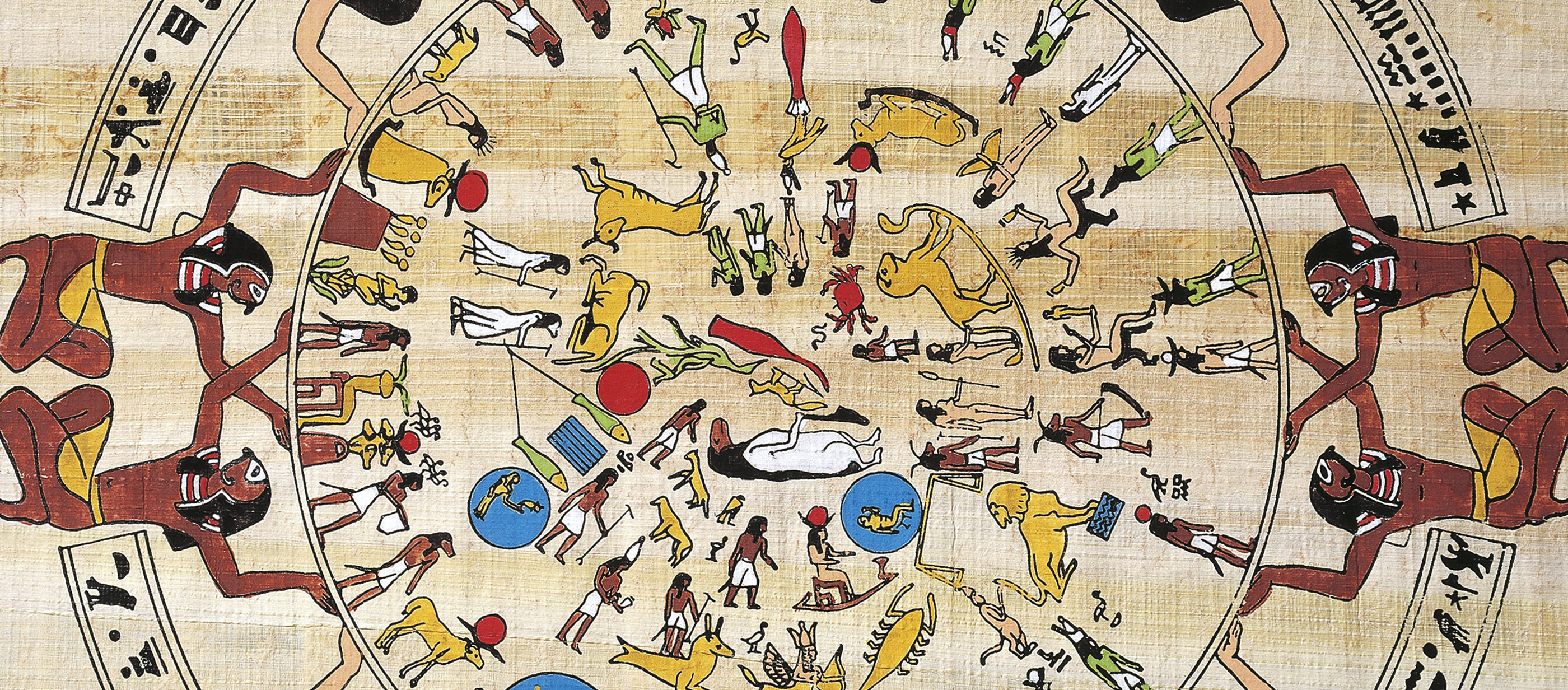
Replica of the zodiac ceiling in the Temple of Hathor, Dandarah, Egypt, papyrus, c. 320 BC. (Papyrus Museum, Cairo, Egypt / De Agostini Picture Library, Bridgeman Images)
It wasn’t only the sacred calendar that could be made to govern temporality. The four seasons themselves and even the parts of the day are subjected to arithmetical sanctification in The Golden Legend. The Mass, said at least once every day of the year, could also be interpreted as world-shaped and -sanctifying. When I was an acolyte, the Mass began, as it had for centuries, in the uncertainty and doubt of deviation: Quare me repulisti, I’d ask God, age twelve, kneeling at the altar in my cassock, et quare tristis incedo, dum affligit me inimicus? Why do you reject me, and why must I go on in sorrow, while my enemy afflicts me? Renewal and reconciliation are figured in the miraculous changing of bread and wine into the body of Jesus Christ, the center point of the Mass, as the birth of Jesus in a living body is the center of human time. And at the end, the Pilgrimage must continue—Ite, missa est. In those days I could have served at Mass in any Roman Catholic church in the world: it was everywhere the same.
The sacraments that, one by one, I partook of as I grew also had each a temporal aspect. Baptism began life anew after the mess and pain of birth and original sin; first communion began a cycle of subsequent communions, but confirmation occurred just once, marking (like the bar mitzvah) the leaving of childhood and the beginning of adult life. On ahead lay marriage and the anointing of the sick, or extreme unction, as it was alternatively named, pronounced by youth in my part of the Catholic world as “X-tree Munction” and as mysterious as it sounded. If the Christian sacraments are, as critic Terry Eagleton has lately written, “signs which accomplish what they signify,” then for me what they accomplished was the inscription of sacred time in my soul.
But even as my family and I lived by the temporale of the Catholic calendar, we measured time by an unsacred sanctorale, one just as rich with incident as Jacobus’ but that reached far further back and extended forward without limit. One that accounted for my existence but asked nothing of me; one whose truth to time was established by instances of refutation as much as by confirmation.
In November 1953, when I was eleven, Time magazine reported on the exposure of a long-ago scientific hoax; the title of the article was “End as a Man”:
For more than a generation, a shambling creature with a human skull and an apelike jaw was known to schoolchildren, Sunday-supplement readers, and serious anthropologists as “the first Englishman.” He was “Piltdown Man,” and he was supposed to have lived anywhere from 750,000 to 950,000 years ago. Last week three British scientists, armed with modern chemistry, demolished Piltdown man.
My family had a subscription to Time—its general pro-Catholic, “American Century” disposition aligned with my father’s, and it had a middlebrow aura of intelligent probity. I may have read this article—probably would have, if I saw it. I was fascinated by fossils and archaeological finds. I looked for fossils in Kentucky slate, and faked one myself when I grew restive at finding none: a nice little trilobite, etched into stone by knifepoint and pretty convincing (to me). Piltdown Man’s relics were made from a human cranium and the jaw of an ape—an orangutan, actually—and a single canine, ground down to resemble an early human’s tooth. The oddity never fit with other early humans in that ascension shown in old textbooks (and still seen in cartoons) from remotest knuckle-dragging ancestor to modern man. The fake ancestor, Time said, may not have been planted by his original discoverer: “More likely, the difficult hoax was perpetrated by an erudite joker who enjoyed in silent satisfaction his success in fooling the experts.”
One of those jokers, it would later appear, may well have been a young paleontologist and Jesuit priest who went on to formulate his own highly original theory of the descent of man from nonhuman ancestors and man’s future ascent through millennia of evolution to a posthuman omega point. Pierre Teilhard de Chardin was a hero to a certain class of educated Catholics of the 1950s: a priest and a scientist, a thinker who seemed able to reconcile two kinds of time: the immensity of unfigurable pastness and futurity, and Jacobus’ box of time shaped by God from the fiat lux to the Apocalypse.
Born in 1881 and enrolled in a Jesuit boarding school at ten years old, Teilhard in one sense exemplified the old Jesuit belief that if they have the boy they will ever after retain the man, but orthodoxy never quite retained Teilhard. He entered the novitiate at eighteen, studied the standard subjects as well as physics and geology, and later did a course in theology at Ore Place, a seminary in Sussex, England, founded by French Jesuits. It was there, he said, that he became convinced of the truth of Darwinian evolution, which “haunted my thoughts like a tune.” Ore Place was located very near to Piltdown, and Teilhard became close friends with the amateur archaeologist Charles Dawson; they often went fossil hunting together, and Teilhard found the canine tooth that appeared to match the Piltdown jaw. Dawson announced the finding of the Piltdown fossils in 1912, the year after Teilhard was ordained.
Three years before the debunking of Piltdown Man was described in Time, Pope Pius XII in the encyclical Humani generis declared that certain aspects of Darwinian evolution weren’t intrinsically in conflict with church teachings, though (Pius said) Catholics certainly didn’t have to believe in evolution if they didn’t want to. A family like mine—observant, loyal to church tradition and doctrine, but also open-minded and disputatious, certainly did. We knew that the seven days of Creation could be taken as seven eons of vast duration, time enough for bacteria and algae to produce dinosaurs and mammoths through the workings of chance and possibility. Though for several years he worked for the church—as the medical director of a small Catholic hospital in Kentucky and then as the infirmary doctor at Notre Dame—my father leaned toward the idea of two churches, one for the smart and learned who could handle ambiguities and don’t need miracle stories or blessed crucifixes, and another for everyone else, who loved and cared for such things. A family friend, a priest who taught in the history and philosophy of science program at Notre Dame, once told us about a conference he’d attended at which he had a dispute about time with another scholar, an unbeliever; while the unbeliever’s theory of time allowed for the (theoretical) existence of angels, the priest’s did not. He thought that was amusing, and so did we. We sometimes attended his masses; he married two of my sisters. If and when Catholics like my family felt the need for a system to account for how they thought, there was Pierre Teilhard de Chardin.
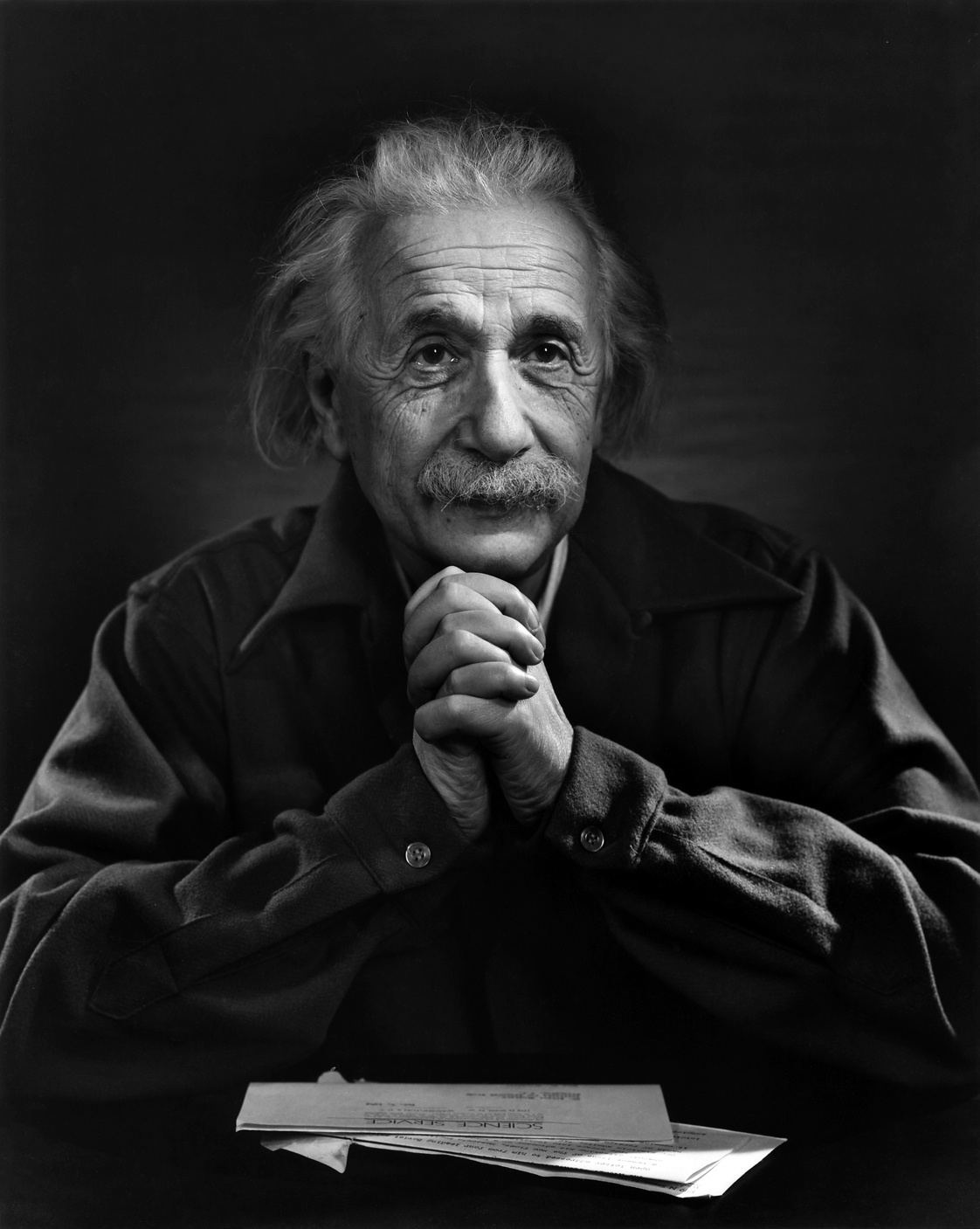
Albert Einstein, by Yousuf Karsh, 1948. Gelatin silver print. © Estate of Yousuf Karsh.
Teilhard was a believer in deep time, the long processes of geological and biological evolution that stretched out over the billions of years of earth’s existence. He hunted fossils with Roy Chapman Andrews of the American Museum of Natural History in New York, a hero of mine in boyhood, and in the 1920s participated in the excavation of Homo erectus in China, then dubbed “Peking Man.” No one’s time scheme was longer than Teilhard’s: none began further back, or went further on. In his best-known book, The Phenomenon of Man—the one we owned—Teilhard built his universe carefully from primal atoms and molecules through living matter to consciousness and the human world, evolving without cease until transitioning finally into eternity.
For Jacobus, time begins with Adam’s fall; for Teilhard, it is the coming into being of a biosphere—the life layer of earth, as opposed to the underlying inorganic geosphere. From the Russian scientist and metaphysician Vladimir Ivanovich Vernadsky, Teilhard adopted a tripartite hierarchy of geosphere, biosphere, and noosphere, from the Greek nous, mind: the realm of thought and self-reflection, the vast and growing network of mental connections belonging only to humans. The noosphere was Teilhard’s sanctorale, that by which time makes sense in consciousness; in Julian Huxley’s formulation, which Teilhard embraced, humankind is how evolution becomes conscious of itself. As science and communication technology stretches a membrane of human connection over the whole earth, and any person can be in all places at once, then sooner or later—a very long time from now in either case, but helped on by human striving—an omega point is approached, where the universe reassembles all consciousness in itself, yet in which every individual consciousness remains separate. The last step depends on God and Christ: “a prodigious biological operation,” Teilhard wrote, “that of the redeeming incarnation.” Not so much a Second Coming as the final instantiation of an evolving divine person born in Bethlehem, Jesus is both beginning and end for Teilhard, as central to his immense loom of time as he was to Jacobus’ brief span from Adam and Eve to the end of the world.
Whether or not Teilhard as a youth at seminary was really involved in the faking of the Piltdown relics—Stephen Jay Gould thought he was, and made a circumstantial case for it in Natural History magazine in 1980—I wonder if those mismatched bones might stand metonymically for the temptation to reconcile the irreconcilable, mix the immiscible. Early in his career Teilhard was censored for unacceptable writings about original sin; in 1925—and in the very week the Scopes trial began—he signed a statement repudiating his opinions. As in the case of Galileo, it was less the threat of new knowledge that alarmed the church than the threat to doctrine. When he submitted the manuscript of The Phenomenon of Man to church censors for scrutiny in 1941—surely a year of backward progress in human evolution—it was rejected for publication, and after the war he was forbidden to teach or write on philosophical subjects. Not until after his death in 1955 did the book appear in French, and in the wake of its worldwide popularity the Holy Office—the same body that condemned Galileo—issued a warning (monitum) stating that Teilhard’s writings “abound in such ambiguities, and indeed even serious errors, as to offend Catholic doctrine,” and Catholic institutions were instructed “to protect the minds, particularly of the youth, against the dangers” they presented. Whatever Teilhard himself imagined, his thought couldn’t be easily reconciled with standard catechisms.
Then came John XXIII (recently canonized) and aggiornamento, or modernization, and the hierarchy began to perceive in Teilhard’s grand synthesis a path to resolving the tension between faith and science, which at that time seemed so urgent and so hurtful to the church. Instead of standing pat, faith had to ante up, lay a very big bet, if it was to recoup its losses. Teilhard’s thought held out the possibility that nothing needed to be given up or painstakingly reconciled; no matter how big the universe got, how long the time frame, deep time was sacred time, and the story that could be told about it could be seen to be the simple Christian story after all.
Of course the bet was hedged: “It must be regarded as an important service of Teilhard de Chardin’s that he rethought these ideas from the angle of the modern view of the world and, in spite of a not entirely unobjectionable tendency toward the biological approach, nevertheless on the whole grasped them correctly and in any case made them accessible once again”—so wrote a German theologian named Joseph Ratzinger in 1968. Such delicate reservations. Long before then I had vacated the premises.
I can’t say how or by what gradual steps the sacred calendar was erased within me, but I remember a time and place when I knew it had vanished away. It was a feast day, a holy day of obligation, in fact, August 15, the assumption of the Virgin Mary into heaven in her sanctified body. As I see it in memory I am returning from church alone along the dirt road to my house, in the Indiana August heat and dust, and—at the advancing tip of a chain of thought that I can’t recall—I said aloud I give it up; I just don’t care. I had (I thought then) no argument against it all, no case for its general untruth or absurdity; for all I knew the world was just as the church claimed it to be. I simply had no soul investment any longer in it, I was outside it then and always would be. It didn’t feel like loss, nor like liberation; it was more like the moment when you understand without surprise that you are not actually walking the streets of a strange city with odd companions but awake in your own bed. I had lost my faith, as the church would say it, though I think the reverse is just as true. In fact I’m not sure that faith was ever what I had. I think I was not capax Dei, in Augustine’s phrase: I had, and have, no capacity for God. Living in the sacred time you didn’t really need it; you didn’t even need belief. All you needed were five senses, a sacerdotal language, and the solemnities of repetition.
They say, “We only have the life of this world. We die and we live, and nothing destroys us but time.” Yet, not true knowledge have they of this—only belief.
One by one all my family “fell away,” as the phrase used to be. My father assumed that Vatican II would be more thoroughgoing in scrubbing away indefensible doctrines than it was; what instead were removed were rituals and observances as cherished as they were peculiar, whose force in practice lay deeper than reason. My mother, for whom evolution meant mostly the advancement of the human species from exasperating stupidity and cravenness to strength and beauty, loved Teilhard, but maybe for just the reasons the church was wary of. Her other two daughters were not married by a priest, and nor was I.
It was a net loss, counted one way at least. Sacred time is also human time, linking generations to one another, binding those who do this in this way at these times with all those who in the past did likewise. My Jewish wife, from a large extended family which now includes me and our children, never had difficulty retaining many of the practices and prayers she grew up with, which connect her to past generations and to a timeless realm as well. I have never succeeded wholly in convincing her that continuing with my own traditions (those that remain) would require sincerely committing to certain metaphysical propositions, as hers—in her estimation—do not. She disputes the distinction I make between sacred and secular time. What about Halloween? A commercial holiday that the whole nation participates in, as it does in Memorial Day (both days of the dead, it occurs to me); a public community festival with roots in immemorial folk practice, that was at a particular time turned to the uses of the church. Jacobus de Voragine extols it, the feast of all the saints that ever were or ever will be, whose feast days mostly can’t be known but which fill the calendar beyond repletion. It’s among the last of the feasts he celebrates before Advent comes around again.
Presentism—the notion that everything that exists is only what can and does exist right now—is countered in metaphysics by eternalism: the idea that time is not a process but a dimension, and in that dimension all reference points have equal validity, and thus all time, past, present, and future, exists at once, extending (like space) in all directions. Augustine believed that while we live along the vanishing knife edge of the present, God has the eternalist view: God perceives time as a block, everything existing simultaneously, all complete to his sight. Teilhard might say: time is Christ’s body, and once in it we too will know all of time at once, and share that eternalist perspective.
You could say that a calendar, which seems to mark time moving from future to past, is actually an eternalist device: all possible pages, all possible dates, are already present in it, endless marchers around a Möbius strip of here-and-nowness. Most calendars measure only a year, but they also measure any year; they keep our old appointments and anniversaries forever, Christmas an eternal December 25, only the moveable feasts sliding within their fixed round of possibilities as the moon comes and goes.
I’ve never been good at keeping calendars, and my family says that I am lax on anniversaries and insufficiently moved by feast days (though I do love fireworks and Thanksgiving dinner). I keep one calendar, though: one so singular and private I can’t know if everyone, or even anyone else, has one like it—though I suspect some must. It’s without dates; the occasions that fill it have no fixed number and don’t recur in any sort of chronological order. Each is a return of some long-ago circumstance in a kind of momentary entirety: the flavor, the taste, the total sensation of it; a past moment in the present. Marcel Proust tasting his teacake was led to remember in detail an earlier, a first instance; and (I suppose) other bites of similar cakes produced that moment for him again ever after, though perhaps with diminishing intensity. For almost all of mine I can’t discover an original, though I believe an original is what I am visited by. I can’t keep them; the calendar is self-erasing.
These instants give me nothing to ponder or to celebrate; they aren’t joyful or somber, express nothing but the intensity of felt existence. Some return many times, some never again. Sometimes they have a catalyst: lately I have felt them brought on by the deeply saturated colors of certain new cars passing me on the highway, chrome yellow, cherry red, teal. What am I reminded of? What in the chaos of my interior is being drawn out, like W.C. Fields plucking just the desired document from the apparently hopeless disorder of his rolltop desk in Man on the Flying Trapeze? Maybe nothing; maybe after all these aren’t memories—discrete moments of the past drawn into the present—but rather glimpses into a timeless time in which all moments have equal standing, are therefore not moments but the signs that Terry Eagleton says accomplish what they signify. If all that can exist in past, present, or future exists now, then the time that has passed through our consciousness, flowing continuously without marks or stops in parallel with the tick of clocks, resides there still when it is gone: choosing, in effect all by itself, what we are to know of it.



